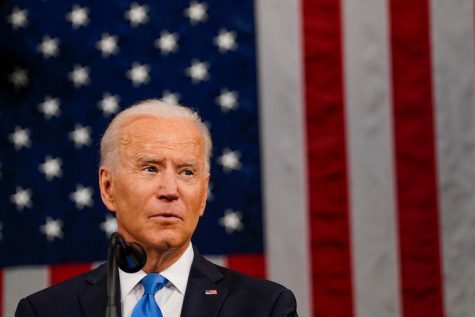Biden’s First Few Weeks Were Lackluster
It’s been just under a month since Joe Biden’s inauguration. In its first few weeks, the administration focused on COVID-19 relief, climate reform, and Donald Trump’s impeachment trial. Some of the reforms enacted by the Biden admin. have been surprisingly good, while others have been somewhat lackluster. So, what has President Biden done so far? What has he failed to do? What’s stopping him?

The most important focus for the Biden administration is COVID-19 relief. On the campaign trail, President Biden repeatedly promised $2,000 checks, specifically adding that if Senators Jon Ossoff and Raphael Warnock were elected, they would go out the door “immediately.” Now, those checks have been decreased to $1,400 to make up a total of $2,000, and are projected to go out sometime in March. I don’t know about you, but that doesn’t feel like “immediately” to me.
Democrats have recently moved to pass a $1.9 trillion COVID-19 relief bill through budget reconciliation. The bill includes “$1,400 direct payments to most Americans, a $400 per week federal jobless benefit through September, and $350 billion for state, local and tribal relief.” Additionally, it includes $170 billion for K-12 schools and higher education, along with $20 billion for a nationwide vaccination program.
If Democrats could go through budget reconciliation this whole time with Vice President Kamala Harris’ go ahead vote, why not pass this bill as soon as they announced it? It’s a shame that before the second relief bill, the public received just $1,200 throughout a ten-month pandemic.
As negotiations regarding a third bill continue, Democratic congresspeople, along with President Biden, have stated that they’re open to decreasing the income cap from $75,000 to $50,000 for individuals, and from $150,000 to $100,000 for married couples. This is wrong. For one, the adjusted gross income (AGI) used to calculate eligibility is based on your 2019 tax returns. This statistic fails to take into account the incredible economic toll the pandemic has had on individual families, and is an inaccurate representation of the population.
Luckily, the recent House version of the bill does not lower income caps, and allows payment decisions to be made based on 2019 or 2020 AGI. If the Senate moves to lower the income cap for the third relief check, then not everyone who received the Trump administration’s $600 payment will receive the Biden administration’s $1,400. This isn’t fair, and given the unpredictable individual effects of the pandemic, we cannot know exactly who needs relief and who doesn’t. Moderate Senate Democrats like Joe Manchin (WV) have already stated that they want to lower the threshold, meaning the House bill will likely have a hard time making its way through the Senate unscathed. As Rep. Alexandria Ocasio-Cortez put it, “Millions are on the brink of eviction. Give too little and they’re devastated. Give ‘too much’ and a single mom might save for a rainy day. This isn’t hard.”
So, how many people will miss out on the second half of the $2,000? Former Federal Reserve and Council of Economic Advisers economist Claudia Sohm projects that roughly 40 million people could miss out if the Senate lowers income caps. Not only will this decrease hurt American families, it will hurt the Democrats politically. 40 million people will have gotten $600 from the Republican Trump administration, and $0 from the Democratic Biden administration. Keeping money out of the hands of working Americans is not the best midterm strategy for 2022.
Another topic of debate in the recent COVID-19 relief bill is the inclusion of a wage hike that would more than double the current minimum wage, moving it from $7.25 to $15.00 over a four year period. The progressive wing of the Democratic Party has been pushing hard for this addition, while moderate senators (welcome back, Sen. Manchin) have opposed it. The “Fight for 15” has been a main goal for American progressives for almost a decade, but this legislation is too little, too late.
While a gradual increase to $15 an hour over the next four years would help millions of workers make their way out of poverty, we must do more. In 2020, the Department of Health and Human Services determined that the poverty level income for a family of four was $26,500, or roughly $12.60 an hour for a full-time worker – $5.35 more than our current federal minimum wage.
A living wage is “enough money to buy the things that are necessary in order to live, such as food and clothes”, and must at least be greater than the poverty level. For someone working the federal minimum wage to make $26,500 and therefore live above the poverty line, they would have to work more than 70 hours a week. As it stands, the federal minimum wage does not provide a living wage for most Americans. Congress should raise the wage to at least a livable level immediately, and gradually increase it from there.
For those who believe that a federal minimum wage should not necessarily mean a living wage, look no further than President Franklin Delano Roosevelt’s speech following the signing of the National Industrial Recovery Act of 1933, the legislation which permitted the establishment of a minimum wage. “By living wages I mean more than a bare subsistence level-I mean the wages of decent living.” Everyone is entitled to a living wage, take it from the man who first implemented the program.
Not only are workers entitled to a living wage, there is a precedent to provide them with one, as that is how the program was intended to function. For those who say that it would hurt small businesses, refer back to that same speech: “No business which depends for existence on paying less than living wages to its workers has any right to continue in this country.”
The minimum wage should, at the very least, equal a living wage, and Congress ought to act to raise it immediately. Whether that’s included in the relief bill, or is passed on its own, it needs to happen, and it needs to be more than $15 by 2025.
Moving on, President Biden’s climate action has been good, but not good enough. On the one hand, the administration has reentered the Paris Climate Agreement, suspended the Keystone XL pipeline, and established new bureaucratic entities to fight climate change. He’s committed to a temporary moratorium on new oil and gas leases, but even this isn’t enough. On the other hand, President Biden continually pushed the message that he would not ban fracking while on the campaign trail. He has maintained this sentiment after taking office, adding, “Let me be clear, and I know this always comes up: We’re not going to ban fracking.” Juxtapositionally, he also claimed to “believe science” on the campaign trail. Does he really? Scientists frequently argue that a fracking ban is crucial in the fight to end climate change, but President Biden refuses to do so. If President Biden really “believes science”, he will call on Congress to immediately ban fracking.
When it comes to climate change, moderate reform doesn’t solve the problem, it just delays the consequences. On this issue, it’s all or nothing, and somewhere in between still means nothing. As CNN put it, “In other words, ExxonMobil and Chevron can continue to frack away.”
President Biden’s other actions have followed a similar pattern. For one, he has mandated the Department of Justice not to renew contracts with private prison companies. Sure, this is good, but again, nowhere near enough. This executive order only affects Department of Justice contracts. It doesn’t affect Immigration and Customs Enforcement, also known as ICE. For context, only 9% of Department of Justice prisoners live in private prisons, whereas upwards of 70% of ICE detainees are kept in private prisons. While it helps, it doesn’t solve the problem, and the executive order normalizes the horrific conditions that prisoners in government-run prisons face.
Specifically, the executive order says, “privately operated criminal detention facilities do not maintain the same levels of safety and security for people in the Federal criminal justice system or for correctional staff. We have a duty to provide these individuals with safe working and living conditions.”
In this part of the executive order, the Biden administration suggests that the federal criminal justice system is safe. While yes, private prisons are more dangerous, and their prisoners are treated worse, this doesn’t change the fact that government-run prisons are bad, too. One of the many issues facing American prisoners is food quality and quantity. Prisoners are 6 times more likely to suffer foodborne illnesses, and food shortages “have been the basis of prison riots throughout history.” “Safe working and living conditions” are basically nonexistent in prisons, private or not.
As the American Civil Liberties Union put it, “most prisons are overcrowded, often dangerous, provide sub-standard medical and mental health care and do nothing to prepare prisoners for when they return to the free world”. To really solve “the prison problem”, President Biden must reform the incarceration process, reinstate parole for federal defendants, and truly better living conditions for all prisons.
The language and scope of this executive order suggests that the Biden administration feels that private prisons are bad, government-run prisons in their current state are okay. This implies that the Biden admin will not seek further prison reform, which is not a good sign.
Further evidence of this was recently released, as new reports have come out that detail President Biden’s campaign contributions in comparison to Trump’s. According to the report, “13 border security companies’ executives and top employees contributed three times more to Joe Biden ($5,364,994) than to Donald Trump ($1,730,435).”
This shows that many border security companies feel they could do better under a Biden administration rather than a Trump administration. It additionally indicates that his executive order on private prisons in the DOJ may be the end of his private prison reforms.
Another example of President Biden’s “good, but not good enough” reforms is his repeal of Trump’s transgender military ban. While transgender people are entitled to all of the same rights as cisgender people, including the right to join the military, it is not necessarily in their best interest to do so. The U.S. government systemically oppresses trans people, and fighting to support a government which oppresses you is not necessarily a sound decision. Outside of this, President Biden must pass serious trans rights legislation if he truly wants to protect the heavily marginalized group.
On a larger note, the American military has historically been used to protect American economic interests. It takes everything from its soldiers, and gives them nothing back. Many veterans suffer from PTSD, homelessness, and severe trauma, whether it’s from the line of duty, or simply from training. To be fair, the Biden admin has taken steps to roll back American interference in international conflict, ending American support for the Saudi Arabian government’s war on Yemen. On the other hand, it has committed to maintaining a defensive relationship with the Saudis, and will also “continue operations against al-Qaeda in the Arabian peninsula.”
It’s also worth noting that although President Biden committed to leaving Afghanistan in 2014 during his tenure as Vice President, his administration is indicating that they plan to maintain a military presence in the country going into the future. We have been in Afghanistan since before most people reading this were born, and it has cost the United States thousands of human lives, and hundreds of billions of dollars. Not only this, Afghan death tolls dwarf American ones, as the Afghan government reported that between 2014 and 2019, more than 45,000 Afghan soldiers had been killed in the conflict. On top of this, the United Nations Assistance Mission in Afghanistan has estimated that Afghan civilian casualties are higher than 100,000 since 2009.
To really fix the United States military problem, the Biden administration must commit to pulling all troops out of Afghanistan. Additionally, he must end the military industrial complex, which has continually increased military spending for the benefit of companies like Raytheon and Lockheed Martin. This is a huge task, and likely won’t happen, but socially progressive reforms do not change the exploitative, murderous nature of the US military.
Finally, the Biden administration’s first month has been preoccupied with the impeachment trials of former president Trump. While what he did during the Capitol riots was incredibly wrong and unconstitutional, what have we gained from the impeachment trial?
Trump’s team could have put cardboard cutouts of lawyers in the Senate and gotten the same result. The impeachment trial set a precedent. Elected officials, if influential enough, can incite violence on their own government, and get away with it. If your party is loyal to you, you can get away with causing the death of American citizens.
Not only this, the impeachment trial impeded Congress. Had we simply moved on, rather than had a trial with a predetermined negative result, Americans may have been able to get relief checks sooner. Now, the Senate is on break, so we’ll have to wait even longer before getting help.
In conclusion, the Biden administration’s early executive orders land somewhere between okay and good, but the new government has got a long way to go before being good enough.

My name’s Luke, I’m editor of the Lance this year, and I’m super excited to be a part of such a great program! I'm a senior at Hellgate, and this...




